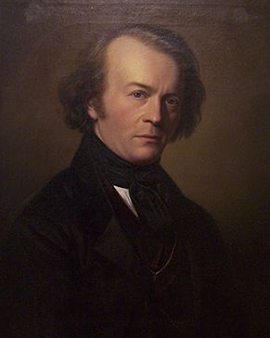The early morning haze still hangs over the Elbe meadows as the painter Ernst Ferdinand Oehme enters the idyllic landscapes of Saxon Switzerland. Born in Dresden on April 23, 1797, Oehme had an artistic talent that was as versatile as it was expressive, making him one of the most characteristic representatives of German Romanticism. After initial self-taught attempts, he was accepted at the renowned Dresden Art Academy in 1819. It was the beginning of an artistic journey that was to have a decisive influence on the aesthetics of his time. That same year, Oehme became a student of the Norwegian painter Johan Christian Dahl, who had found his way to Dresden after studying in Copenhagen. It was Dahl who introduced Oehme to his friend Caspar David Friedrich, one of the most influential painters of his generation. Inspired by the visionary ideas of Friedrich and in close exchange with his pupil Johann August Heinrich, Oehme began to study nature around Dresden intensively. He moved outdoors, explored the wilderness of Saxon Switzerland and transferred what he saw into impressive paintings, such as the work "Waldinneres" (1822).
Even in his early career, Oehme surprised the art world. At the 1821 Academy Exhibition, he presented his painting "Cathedral in Winter," showing monks making their way through the winter night snow to a Gothic church. One could almost hear the whisper of the wind and see the flickering candlelight at the high altar. The influence of Friedrich is palpable in this work, especially when compared to Friedrich's work Abbey in the Oak Forest (1809/1810). But Oehme was not only a student, he was also an innovator. In the 1830s, he began to break away from Friedrich's influence and developed a landscape depiction that was more realistic and less steeped in symbolism. Oehme died in Dresden in 1855, and his grave is in the Old Annen Cemetery in Dresden's southern suburbs. He left not only a son, Erwin, who also became a painter, but also an artistic legacy that continues to this day. As a company specializing in the production of art prints, we are proud to reproduce the works of Ernst Ferdinand Oehme. The careful reproduction of colors, the accurate replication of details, all serve to honor the spirit and skill of this great artist. With every art print we produce, you will feel the magic and mysticism of German Romanticism, as if you were walking through the landscapes of Saxon Switzerland yourself.
×





.jpg)
.jpg)
.jpg)
.jpg)
.jpg)
.jpg)
.jpg)
.jpg)
.jpg)
.jpg)
.jpg)
.jpg)
_-_(MeisterDrucke-1584396).jpg)
_-_(MeisterDrucke-1584396).jpg)
.jpg)
.jpg)
 Rocky Forest with Strollers (verso) - (MeisterDrucke-8241).jpg)
 Rocky Forest with Strollers (verso) - (MeisterDrucke-8241).jpg)
.jpg)
.jpg)
.jpg)
.jpg)
.jpg)
.jpg)






